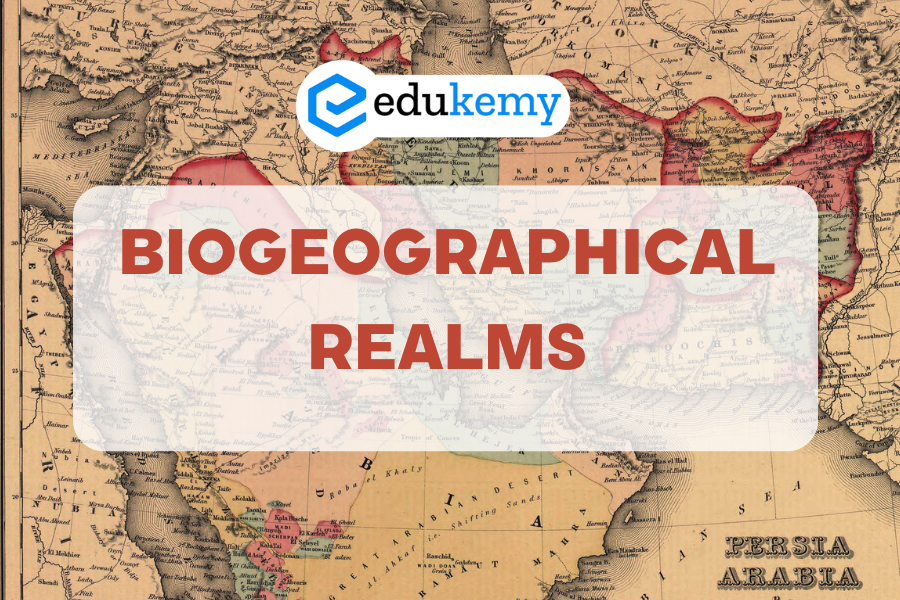Understand biogeographical realms, their significance in geography, ecology, and UPSC preparation. Master this key concept for competitive exams.

Contents
What are Biogeographical Realms?
Biogeographical realms refer to large-scale regions of the Earth’s surface, which are defined based on the distribution patterns of flora and fauna. These realms represent regions that share similar environmental conditions, ecosystems, and species that have evolved over time, influencing the biodiversity found within them. Essentially, these realms are large areas where the plant and animal species exhibit similarities due to shared evolutionary history and climate conditions.
The concept of biogeographical realms is important for understanding the distribution of life on Earth, as well as the impact of historical, environmental, and geological factors on biodiversity.
Check Shabbir Sir’s Class Notes
Click Here to download
Major Biogeographical Realms
Geographers have divided the world into several biogeographical realms, each characterized by distinct climatic conditions, terrain, and ecosystems. These realms are often further divided into smaller regions, called floristic regions or faunal regions. Let’s take a closer look at some of the major biogeographical realms:
1. Nearctic Realm
- Location: North America (excluding tropical regions)
- Flora & Fauna: Characterized by cold to temperate climates, this realm supports coniferous forests and grasslands. The faunal population is quite diverse, with animals like bison, grizzly bears, and species adapted to cold climates, such as wolves and moose.
- Environmental Features: It includes North America, from the Arctic in the north to the tropics in the south.
2. Palearctic Realm
- Location: Europe, northern Asia, and parts of North Africa.
- Flora & Fauna: One of the largest realms, it encompasses a variety of ecosystems such as tundra, boreal forests, and temperate forests. Iconic species include the Siberian tiger, brown bear, and reindeer.
- Environmental Features: The Palearctic Realm is the most extensive, covering almost half of the Earth’s land area. It is known for its harsh winters and vast steppe regions.
3. Neotropical Realm
- Location: South and Central America, including the Caribbean
- Flora & Fauna: Home to the world’s most diverse ecosystems, such as tropical rainforests and savannahs. Biodiversity is staggering, with species like jaguars, sloths, and toucans. Tropical rainforests are particularly rich in endemic species.
- Environmental Features: The realm is known for its warm temperatures and high humidity. The Amazon rainforest is the world’s largest and most biodiverse tropical rainforest, located in this realm.
4. Afrotropical Realm
- Location: Sub-Saharan Africa
- Flora & Fauna: This realm is rich in both flora and fauna. It includes savannas, deserts, and tropical forests. Faunal diversity is exceptional with species like elephants, lions, and gorillas. Africa’s vast savannahs and rainforests contribute to a dynamic ecology.
- Environmental Features: Characterized by hot climates and seasonal rainfall patterns, this realm is often marked by dramatic climatic shifts, including the wet-dry seasons in tropical areas.
5. Indomalayan Realm
- Location: South and Southeast Asia
- Flora & Fauna: Known for its highly diverse ecosystems, this realm features tropical rainforests, montane regions, and coastal mangroves. Iconic species include tigers, elephants, and rhinoceroses.
- Environmental Features: Tropical climates dominate the area, with significant rainfall year-round. Monsoon systems influence the weather patterns in most of the region.
6. Australasian Realm
- Location: Australia, New Guinea, and surrounding islands
- Flora & Fauna: Famous for unique species such as kangaroos, koalas, and the platypus, the Australasian Realm has highly specialized ecosystems, particularly in the dry outback and tropical forests.
- Environmental Features: This realm exhibits an arid central region, with lush rainforests in the coastal zones. Australia’s isolation has allowed for a distinct evolution of flora and fauna.
7. Oceanian Realm
- Location: Pacific Islands
- Flora & Fauna: The islands in the Pacific, including the Polynesian, Micronesian, and Melanesian regions, have unique ecosystems. Marine life is rich, with species adapted to island living.
- Environmental Features: Characterized by tropical climates and coral reef ecosystems, this realm is marked by both volcanic islands and atolls.
8. Antarctic Realm
- Location: Antarctica and surrounding Southern Ocean
- Flora & Fauna: This is one of the least biodiverse realms, primarily due to its harsh cold climate. The fauna here includes penguins, seals, and a variety of marine life like krill.
- Environmental Features: Extremely cold temperatures and icy conditions prevail, with little vegetation. The realm is unique for its oceanic and glacial ecosystems.
Key Concepts to Understand Biogeographical Realms
- Climate and Environmental Factors: Each biogeographical realm is shaped by a combination of climate (temperature, precipitation, and seasonal variations) and physical geography (terrain, altitude, and proximity to oceans). For example, tropical rainforests are found primarily in regions near the Equator, while deserts dominate areas with low precipitation.
- Plate Tectonics and Evolution: The distribution of realms has also been influenced by historical events such as plate tectonics and continental drift. As continents moved over millions of years, the flora and fauna adapted to isolated environments, leading to the development of distinct ecosystems and species.
- Adaptation and Evolution of Species: The flora and fauna in each realm have adapted to the unique climatic and environmental conditions of the region. These species have evolved over millions of years to form highly specialized ecosystems. For example, the isolation of Australia led to the development of species like the kangaroo and platypus, which are found nowhere else.
- Human Impact: Today, human activity is altering the distribution of species and ecosystems across the world. Deforestation, climate change, and the introduction of invasive species have significant impacts on the biogeographical realms.
Conclusion
The study of biogeographical realms is an essential aspect of understanding how life on Earth has evolved and adapted to different environments over time. It helps students grasp the relationship between living organisms and their environments, providing insight into the ways in which ecosystems function and thrive. For Geography Optional students, mastering this concept is crucial, as it ties into both physical and human geography, and can enrich their understanding of global patterns of biodiversity.
By understanding the characteristics and distribution of biogeographical realms, students not only enhance their knowledge for exams but also gain a deeper appreciation for the planet’s ecological complexity and the urgent need for conservation efforts worldwide.
To get free counseling/support on UPSC preparation from expert mentors please call 9773890604
- Join Geography Optional Course – Click Here
- Get Geography Hard Copy notes – Click Here

